The Shape of Locative Media
As the discourse around locative media art gets into gear, Simon Pope sets some new co-ordinates, and salvages some old ones, to navigate this emergent genre
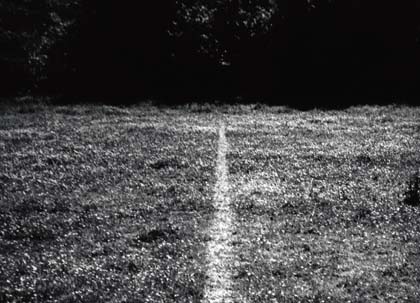
> Richard Long, A Line Made by Walking,1967
It feels like the end of an era with ten years of new media production having just been catalogued by the Arts Council (of) England, (cf. its recent publication, New Media Art: Practice and Context in the UK 1994 – 2004), to coincide with ist reorganisation. There seems to have been a search for the next ‘new media’. If all runs to form, I’d say that those whose work matches the strategy of key institutions will be the ones to have first dibs on their support. And so we get, without much mental contortion, to the subject of locative media. As a field defined outside of the arts sector, the idea of location-specific services has been receiving the attention of mobile phone manufacturers and network providers for a while. I have some anecdotal evidence that the industry has been pouring pre-dot.com era sums of cash into, literally, anything that moves. So applications that enable phones that know where they are in relation to local services have been winners under present conditions. My suspicion is that the overspill of the R&D money and press coverage that these innovations inspire finds its way towards the arts sector pretty smartish. And so I’ve accepted the invitation to write this piece to try to find out what these location based services are or might be, as they are defined in the arts sector.
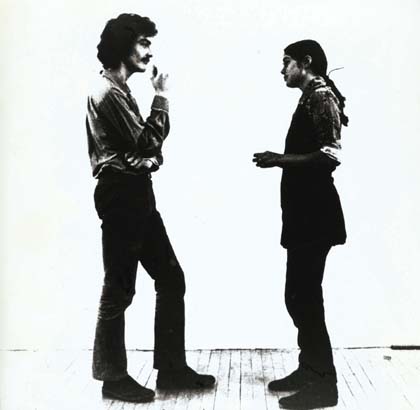
> Dan Graham, Past Future Split Attention, 1972
I understand that locative media is multiple; it’s available to us in many versions, depending on the way that we operate on it, according to the uses we need it to be put to. In my case, for the purposes of this text, I need locative media to conform to my very particular and current interests. As such, it’ll be fashioned according to the following ideas:
1. Some thoughts on so called ‘spatialising practices’
2. A consideration of the mobile agent
3. Some thoughts on ambulant and sedentary knowledge
4. The idea of the Knowable Community, culled from Raymond Williams, and locative media as a fictional form
5. Uses of the map in locative media, Psychogeographic and Conceptual art practice.
This is meant to offer some kind of analysis, but the intimated objectivity of such an exercise is difficult given my relationship with the people involved in this project in its most general form. Rather, this is as much intended as a slight critique and contribution to the project at a stage when the field appears to be opening to wider critical appraisal.
1. It’s been my concern for a while to try to get an understanding of the variously theorised orthodoxies of space and place. There’s a strong chance that you too may have read some of the canonical texts concerned with the relationship between spaces-that-have-meaning-for-us and the abstract systems that describe them as ‘geometric space’. For a very long time, the terms ‘space’ and ‘place’ have been described, in academic disciplines and elsewhere, as being in tension with each other. While the former is lived, the latter exists before, during, after and in spite of living. There has been some attempt to relax this tension by humanising these descriptions of space, to make them softer, less hierarchical, more relative. So, for example, to describe the relationship between things, rather than their absolute position. Yet this still could be considered as just another way of arranging things in space, with no attempt to understand the objects in themselves – how they perceive being spatialised for example. There are critics of this ‘softening’ of course, and my particular favourite is Michael R Curry, especially as his papers are numerous and readily available online.[1]
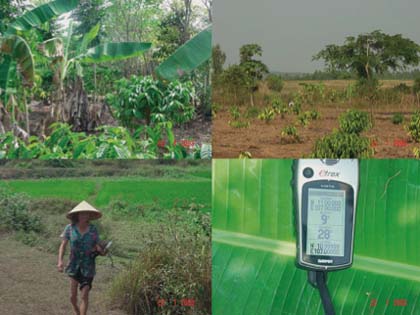
> The Degree Confluence Project, 11°N 107°E, 20.6 km (12.8 miles) ENE of Bien Hoa, Dong Nai, Vietnam, 22 January 2003
In my determined, but laggard, reading of Michel de Certeau, I can find ample theoretical justification for the role of ‘everyday practices’ as a means to resist such spatialising practices.[2] Whether they frustrate or resist the structure that is imposed is not important here. It is the possibility that meaning can be produced at a tactical level, even when a strategic position is denied, that is key. In the case of an imposed structure of spaces – a mathematical description of all possible spaces – it appears that locative media operates at this level of resistance. It startsto take shape as a tactical media: the [murmur] project, for example, has annotated sites in several Canadian cities often overlooked in officially sanctioned histories. Adopting the convention of the ‘commemorative plaque’, spoken word recordings are delivered to mobile phones to provide a commentary on specific locations which are described and located within an established representation of physical space – these are known locations within the scope of street maps.
The Degree Confluence Project is perhaps a good example of a more benign habitation of a conventional structure, displaying less unease or displeasure with the overarching structure than in the case of [murmur]: its stated aim is ‘to visit each of the latitude and longitude integer degree intersections in the world, and to take pictures at each location.’ The results are available from their website as the project attempts to map the world; there is a sense in which this project cannot rest until it is complete, it is impelled to collect data from all possible points defined by the structure.I'm reminded of Augé’s ‘proliferation of spaces’[3] and wonder at the compulsion for locative media projects to acknowledge or even invent these spaces.
Some of the projects that we might recognise as being within the scope of locative media have an altogether different relationship to structure: the RDF project appears key to the field and exemplified by works such as The Locative Packets workshop. This gives a good indication of the ambition of this project, being a thorough and sustained attempt to define an ontology – a worldview – that can adequately describe spatial relationships, as well as enabling agents to inhabit and annotate the space of these relationships. While this project has some of the characteristics of tactical media – appearing to operate within a structure not of its own making – it is now equally strategic in that its influence is felt at an institutional level, with the very idea of ‘locative media’ influential on strategy for arts funders, technologists and research councils alike.
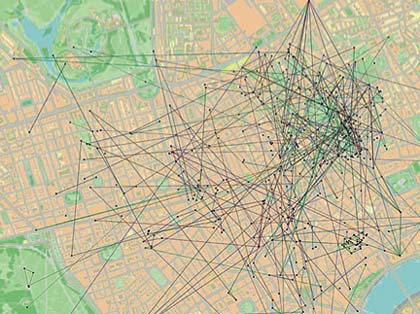
> A map of annotated locations and threads connecting them, created during Proboscis's Urban Tapestries project, June 2004
2. For the past year or so I’ve been making a study of walking as an art practice and, in particular, walking and meeting in the work of André Cadere, Sophie Calle, Vito Acconci, (the very earliest work of) Richard Long and Yoko Ono among others. So, as well as bringing this knowledge into proximity with locative media, in an attempt to become the good academic that I'll never be, I'd also like to bring walking towards locative media as a methodology: as a way of finding out about the world and, in particular, what happens when a mobile agent operates on these technologies.
My first attempt at this was made in Bloomsbury, London late in 2003 when I joined in the trial of the initial prototype of Proboscis's Urban Tapestries. This was the first time I'd volunteered to use a tangible location-based service such as this, and it soon struck me that, while the technologies are supposedly mobile, PDAs with wireless cards and regular cell phones show an awkwardness when between the points that define their operational space; they have no problem in being portable, but prefer the moment when they can be stationary and in a precise, stable relation to the nearest mast or access point.
The tension between the technology’s demands and those of its user as mobile agent tends to produce an equal awkwardness in us as we use these services. Our technologies appear to construct and perceive only a succession of stable points: locations at which can be found the annotations provided by our location based services. They are a constant reminder of the imperative to think of our movement as a sequence of discrete ‘moments’ at points in space. It seems that locative media operates on our understanding of movement as did photography. We are back to Muybridge and the capture of successive moments in time and space, yet, what is not captured is the smearing between one moment and the next. While at the Lisson gallery’s recent exhibition of the early works of Dan Graham I spent some time with Past Future Split Attention. This piece from 1972 states its premise as being, ‘Two people who know each other are in the same space. While one person predicts continuously the other person’s behaviour, the other person recounts (by memory) the other’s past behaviour.’ The performance is recorded on video tape which is understood as being, ‘a continuum (unlike film, which is discontinuous/ an analytic re-construction) ...’
This suggests a recognition that video technology holds within itself the means to think this blurring of moments and points in space. Its interlaced image already introduces this possibility of understanding ‘the moment’ as being at least constructed from past and present. It takes Graham’s intervention to add ‘the future’ into this compound; far from being discrete chunks of time or points in space, it might be that they are smeared together somehow, so that there’s no longer a clearly defined location to specify. It makes me think about where this form of intervention, by an artist or otherwise, is within the locative media project.
3. Here, I want to propose that there might be different – sedentary and ambulant – forms of knowledge at play both in the works discussed here as locative media and in the Dan Graham piece. Where sedentary knowledge demands a static and stable position for all knowledge, an ambulant knowledge supposes a mobility and a beingbetween. Certain information systems such as collections in libraries and university departments promote these static forms. They are built to promote knowledge in ist consolidated, sedentary form. The operation on, and movement between, static knowledge in all its forms is another matter. Opposed to this is the presumption that knowledge and understanding are in motion and could be, (to lift from the usual suspects D&G), an ambulant knowledge that enables an understanding of being in between stable points: between countries, disciplines, spaces, job descriptions. It enables a know-how, rather than a knowwhat (a paraphrase if ever I’ve heard one...).
4. It still holds true that the relationships between people in the city are thought of as being opaque, duplicitous and corrupt, whereas those in the countryside are deemed to be direct, transparent and healthy. The countryside is a place of earthy common sense and natural order, in contrast to the city’s effete intellectualism and political skulduggery. I recently found, and then lost, a copy of a pamphlet by Raymond Williams, The Country and The City in the Modern Novel[4] – a transcription of a presentation given as an introduction to hisweightier publication of 1973.[5] In it, he asks us to consider how the form of the novel has changed over time, and how it has been used to promote the notion of the countryside as sole site of true, direct human relationships. The contrast between the rural idyll – an escape to the countryside or to an EU accession state – and city life and the social relations that typify it, is still a dominant force when thinking about the ways that we’d like to live. With many location specific projects being trialled within an urban setting, it raises questions as to whether locative media now works as a fictional form. It might be that it is the most recent way of fictionalising our most complex urban social relations, a way of promoting those relationships that are usually considered as contrasting with those found only in a rural setting. In many ways the promise of the free wireless projects – to establish a social network on top of a technical one – brings the promise of convivial relations to an urban setting. It could be said to problematise the simple opposition between city and country. The novelty of theseprojects seem to be in the way they extend the human community to include an array of agents, arranged in space which includes antennae, rooftops, trees, buildings, masts and the like. Williams also recognises something similar in Dickens’s novels, where buildings, their atmospheres, ambiences and so on, are given the attention formerly thought only worthy of the main, human protagonists. With the technologies of locative media, we are made precisely aware of the scale of built things and their relationship to each other. It’s the built environment that now appears as our preferred ‘knowable community’.
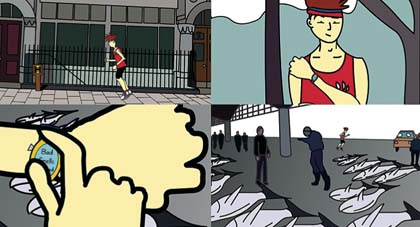
> Stills from animation by Rudegirl Designs demonstrating the Urban Tapestries project, GeoJogging: 'Geo jogging is a system that allows exercise enthusiasts to document or follow good jogging routes’
5. In his essay ‘Mappings: Situationists and/or Conceptualists’,[6] Peter Wollen considers the relationship between the use made of the map by both the SI and Conceptual artists. Despite being contemporaries, each party used the map in very different ways: where Debord et al described human ‘passions’ in relation to urban planning, On Kawara and Douglas Heubler, for example, adopted the map as a device which could banish any emotional response to urban space, implying ‘a kind of scientificity’ in their work, through an explicit alignment with scientific methodology. There is an equal appeal to a ‘scientificity’ in locative media projects, to some extent this must be a necessity in any ‘new media’ practice of course. But nonetheless it raises questions as to how the use of maps, new technology and a language driven towards precision might work to make these practices distinct from others.
It should come as no surprise that there are also echoes of the psychogeographic project in our generally defined field of locative media. Indeed, it has become something of an orthodoxy, with the requisite dissenters and historical revisionists. Ist methods are readily available, the dérive, for example, is described in enough detail and in enough places for it to be an off the shelf solution, so it would be more surprising to find it absent from the field. Yet, for all the availability of the SI’s work, the locative media work advanced under the banner of psychogeography, by Socialfiction.org for example, doesn’t appear to align itself particularly with the original project. There’s a wilful skimming of the surface of psychogeography, taking it to mean an unconstrained movement in the streets, and apparently less of an alignment with the wider project of anti-urbanism. This can leave an impression of a practice whose relation to ‘the city’ is closer to the disinterestedness of Conceptualism than the supposed engagement of the SI.
Of interest here is what lies beneath Wollen's initial readings: he notes that the SI in particular were embedded within a city that was undergoing massive regeneration of its housing stock. Their devices for mapping the interactions and perceptions of human desires onto Paris, for example, were driven not by chance, as were the preceding scorned Surrealist interventions, but rather as a direct and conscious operation on the city. Theirs was a practice that provided them with techniques through which they might understand the process of change that was happening to them, around them and, no doubt, because of them. By contrast, On Kawara and Douglas Heubler were, much less concerned with their rootedness in one particular locale and preempt today’s preference for itinerant artists, spending short periods of time in residencies or performing fleetingly on the circuit of international art fairs. The map, for Conceptual artists, seems more useful as a simple, generic method for recording the spatial aspects of a sculptural practice on an expanded scale; and there are echoes of this in several projects that have fallen under the locative media banner.[7]
This leaves me wondering how those developing locative media understand themselves to be implicated in the spaces that they construct, record and annotate; and I wonder if we will come to learn of the effects of artists, so concerned with locality, on the state of house prices, interest and exchange rates, job markets, tech stocks and so on.
FOOTNOTES
[1] For example: Michael R. Curry, ‘Discursive Displacement and the Seminal Ambiguity of Space and Place’, in The Handbook of New Media, eds. Leah Lievrouw and Sonia Livingstone, London: Sage Publications, 2002[2] Michel De Certeau, The Practice of Everyday Life, Berkeley & Los Angeles: University of California Press, 1884[3] Marc Augé, Non-Places: an Introduction to the Anthropology of Supermodernity, London & New York: Verso, 1995[4] Raymond Williams, The Country and the City in the Modern Novel, pamphlet from a public lecture, Swansea University Press[5] Raymond Williams The Country and the City, first published by Chatto & Windus,1973[6] Peter Wollen in Rewriting Conceptual Art, eds Michael Newman & Jon Bird, Reaktion Books, 2000[7] For instance, Pete Gomez's Location, Location, Location, 2000
Simon Pope <simon AT informal.org.uk> is an artist and NESTA Fellow. He lives in Cardiff and works in Brussels
Mute Books Orders
For Mute Books distribution contact Anagram Books
contact@anagrambooks.com
For online purchases visit anagrambooks.com







